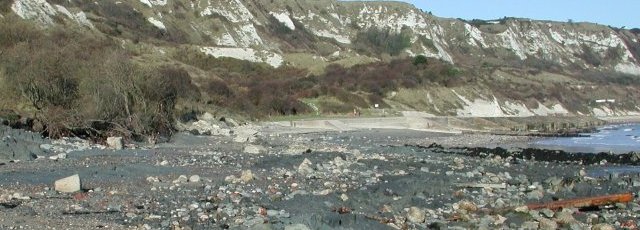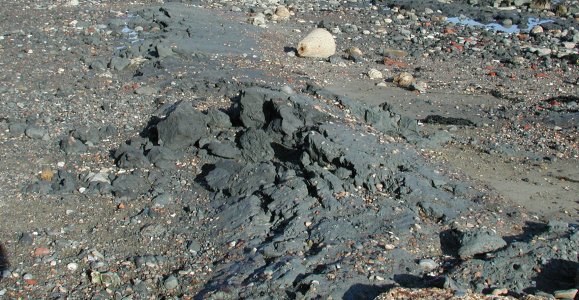EAST WEAR BAY - FOLKESTONE
November 2000



EAST WEAR BAY - FOLKESTONE |
November 2000 |
| East Wear Bay is situated at the eastern end of the Folkestone section. The foreshore is covered by sand throughout the summer and the Gault Clay becomes exposed on the beach after the first autumn storms, usually towards the end of October each year and covered with sand again around the end of March. In recent years there have been accessible Gault exposures in East Wear Bay for about four months of each year. |
| Exceptionally, Beds I through X (the whole of the Middle Albian and lower Late Albian) may be exposed in various places on the foreshore and fossils can be found in all of these. Currently large areas of the less fossiliferous Upper Gault is exposed. Fossils are washed out with each tide and after storms and relatively easy to collect but most are fragmentary and complete specimens scarce. The "mammillatum" Zone at the top of the Folkestone Beds is accessible on the foreshore reefs. |
 |
| 10 November 2000. In the background you can see Folkestone Warren and the westernmost start of the famous "White Cliffs of Dover" which at this point are Upper Cretaceous (Lower/Middle Chalk - Cenomanian through Turonian) in age. In the foreground the Lower Cretaceous (Gault Clay) is exposed on the foreshore after recent storms and beach-heave following a continuing "graben" rotational slip in the low cliffs behind. |
 |
| This example of beach-heave happened on 4th November 2000 when it was possible to observe the clay rising out of the beach over a two-hour period. There was no visible movement in the cliffs. This particular exposure is Upper Gault (Late Albian) in age (Bed IX Hysteroceras orbignyi Subzone). |
 |
| 12 November 2000 - Standing on the concrete apron in front of the Warren Camp Site and facing Folkestone. East Wear Bay (marked) is at the end of the sea defence. The lower cliff has been scoured and along with it most of the surface fossils. The retreating spring high tide has moved sand onto the beach instead of removing it. |